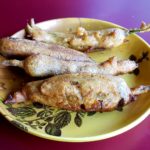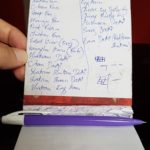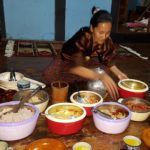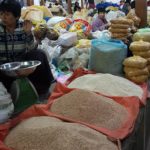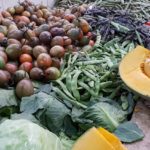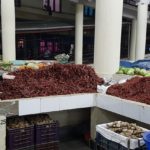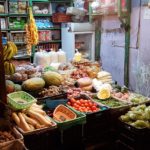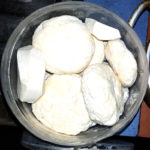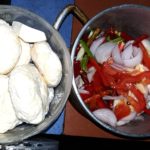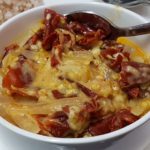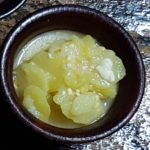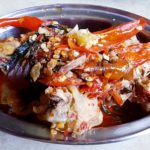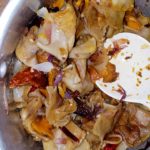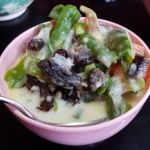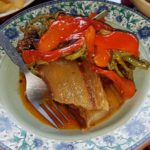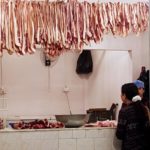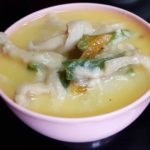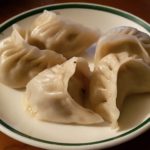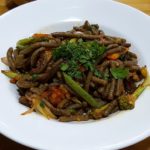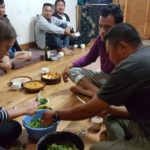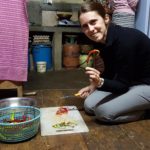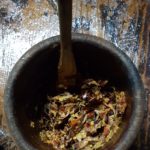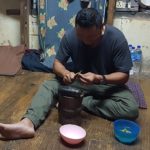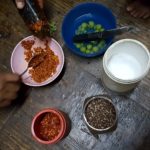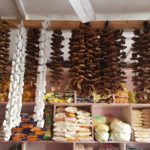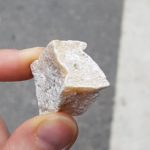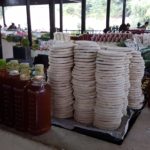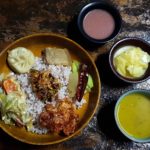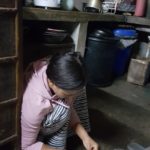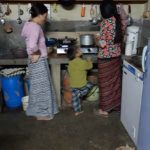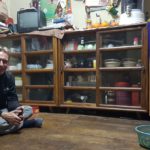I love food and wherever we travel you can find me in the kitchen. Kitchens are social places, there is always an opportunity to support the cook, learn something new and chat with the people, even if this is only with hand and feet.
Let’s take a break form the cultural experiences and get to the culinary side of Bhutan, before we continue staying in a local farmhouse in the Phunaka valley.
Since we travel Bhutan with a guide, which is not our usual travel style, we had to trust on Tenzins’ recommendations. We told him that we want local food and love spicy. We ended up in a restaurant with 100% foreigners as guests and he disappeared when food was served. Food was tasteless and besides the rice, I think there was nothing local. When he reappeared, we asked where he was eating. “Another place where they have food for locals” he said. “That’s the kind of place we want to go tomorrow, don’t get us in a tourist place again please!” we asked him for. “But it is spicy!” he replied to get reminded “We love spicy very much!”.
Eating Bhutanese food is a spicy affair
Long story short: We got tested with some snacks (deep fried chili, some other things I am not sure what it was) and from there on, we did not enter any tourist restaurant (with the exception of the one at tiger’s nest, but we were too hungry and this was the only place. And Tenzin organized some chili paste from the kitchen, so we could manage). Instead of typical restaurants, we tried to eat at farmhouses as often as possible, which is the best you can do…
Bhutanese kitchen is rich in rice (a portion for 4 hungry Germans is just enough for 1 Bhutanese) and chili. There are many vegetables but little meat. In general, Bhutanese don’t slaughter animals, they would eat their cows and yaks once they die. The meat is then dried to make it last. Alternatively, there is import meat from India nowadays and recently a poultry farm has been opened where they would also slaughter the birds.
Cheese – mainly white cheese – is more common. Most farmers have at least one cow for milk or get milk from their neighbors if the cow currently does not give milk. Before the 60s or 70s all cheese was made from Yak milk. Yak only give little milk. A Swiss cheese maker, who came by invitation of the king to help make more and better cheese a few decades ago, decided to first import cows to be able to produce anything…
Once you know the top 10 dishes or food terms, it is rather easy to get around…
1. Ema Datshi (Chili with cheese)
That is the dish, you will always find in any local restaurant in Bhutan. I cannot recall a day without Ema Datshi. Datshi stands for cheese, so you will find the word in combination with other terms. Ema stands for chili, but even if it is not in the name of the dish, be assured, chili is in the dish *smiley winking*
Ema Datshi varies a little from farmhouse to farmhouse. The one I helped cooking in a Punakha farmhouse, contained:
-
- Red chili (about 4 big hand full)
- 8 cloves of garlic
- 1 small onion
- 1 tomato
- White cheese (unsalted, about 3 big hand full)
- Oil (about a table spoon)
- Water (a little)
- Salt (to taste, less / none if cheese is already salted)
Cook gently for 10-15 min. You can eat it with red rice, which is most common in the mountains of Bhutan. Alternatively use white rice.
2. Kewa Datshi (Potato with cheese and chili)
Kewa (Potato) Datshi (Cheese) was our second frequently ordered dish. We like it and it is widely available:
-
- Peeled and sliced potatos
- Lots of green chili (also works with red chilies, but is uncommon)
- Cheese (unsalted)
- Garlic (lots)
- Salt to taste
- A little water
Cook until potatoes are ready, then serve with rice (and other dishes). Same works also with spinach instead of potato as Hantshey Datsi.
3. Shakam Paa (Dried beef)
Shakam stands for dried beef and is a traditional type of dish, cooked with dried chilies (and sometimes slices of radish or some other dried veg like pumpkin) it is really delicious:
-
- Cut tried beef in pieces and cook it
- Stir fry onion, ginger, lots of garlic and even more greet chili in a little oil
- Add the beef and fry for a few more minutes
As all the other dishes, eat shakam paa with lots of red rice (and whatever else you cooked).
4. Shakam Ema Datshi (Dried beef with cheese)
What a yummy combination. It is prepared similar to Shakam paa, with lots of cheese added.
5. Phaksha paa (Pork)
Slices of pork are stir fried with dried chili, onions, garlic and if available vegetables (could be green veggies, radish or dried pumpkin). Quite often pork belly is used, which makes it quite energy intense…
6. Shamu datshi (Mushrooms with cheese)
Another datshi we loved a lot is Shamu datshi. This is mushrooms with cheese, cooked very similar to Kewa datshi. It is always according to the availability of the ingredients. If there are mushrooms, lucky you *smiley winking*
7. Momos (Dumplings)
If there are any, Momos are the Himalayan snacks. The dumplings are steamed buns, filled with mainly veggies, but also minced meat and cheese, it is a yummy snack or also part of a nice dinner. Don’t miss to dip them into ezay, the Bhutanese chili sauce…
8. Puta (Buckwheat noodles)
Since we traveled from east to the middle of Bhutan, but not quite to Bumthang, where Puta with its buckwheat is very common, we only got puta a few times. Buckwheat is very nutritious and is grown in the high altitudes of Bumthang region.
The noodles come boiled or stir-fried with veggies. If you want to eat something other than rice, it is a very yummy alternative.
9. Ezay (Chili paste)
No dinner can go without ezay, the Bhutanese chili paste. It is used like salt and pepper, it just has to be there. However, there is not the one way to make it, variations are very common, which makes it very interesting. This is how we made it in a Dewachen Farmhouse:
-
- Lots of red dried chilies, at least 2 hand full (works also with green chilies, but is not so common)
- 1 onion
- Coriander leaves
- 1 tomato
- 1-2 tea spoons of cheese
- Salt to taste
- Sichuan pepper, mortared
Cut everything really small pieces, stir and press with a spoon to create a paste.
If you like to be make it a bit different, you can also use sour berries and chili powder as we did in Punakha. But it does not get any less spicy *smiley winking*
10. Chogo or chhurpi (rock hard dried yak cheese)
Last but by no means least: dried yak cheese, hard like granite. It is worth a try once in life, but that is enough for our taste. Might be a good business model for dentists in the western world to make this cheese popular as it might well increase their original dentist business *smiley winking* Luckily, I have healthy teeth without seals.
The dried cheese is so hard that you have to chew on it for hours until it dissolves. We were not so patient, after an hour we found someone who was happy to take over…
Digestive: Ara or Arag (Fermented rice drink)
A hearty dinner in a farmhouse often cannot go without an Ara. Not a colorful bird, but a strong fermented rice drink. It is made with yeast, rice and water and some patience until it is ready. The yeast comes shape of a flatbread and is sold in the markets. We bought a few but when we found out some weeks later, when we still traveled in India, that lots were inhabited by bugs, we decided to park the home made Ara project for another time.
Our top 3 learnings
-
- Cutting a salad bowl of hot chili in the hand (as the locals do) instead of on a cutting board, resulted in waking up at night as the palm was burning
- Drying as a preserving method is super common and also good not only for chilies, but many other veggies like pumpkin and even meat
- Rice itself is a main dish
To sum it up: to eat local, you have to be able to eat “Thai hot”, how it would be called in Thailand. Also, eating rice 3 times a day should not scare you off and you should be flexible and not expect any food like you would at home. If you are up to, you will understood the culture much better and it will be an exciting culinary time!
After so much food, let’s get back on the road for a hike in Punakha valley and a relaxed farmhouse stay.


